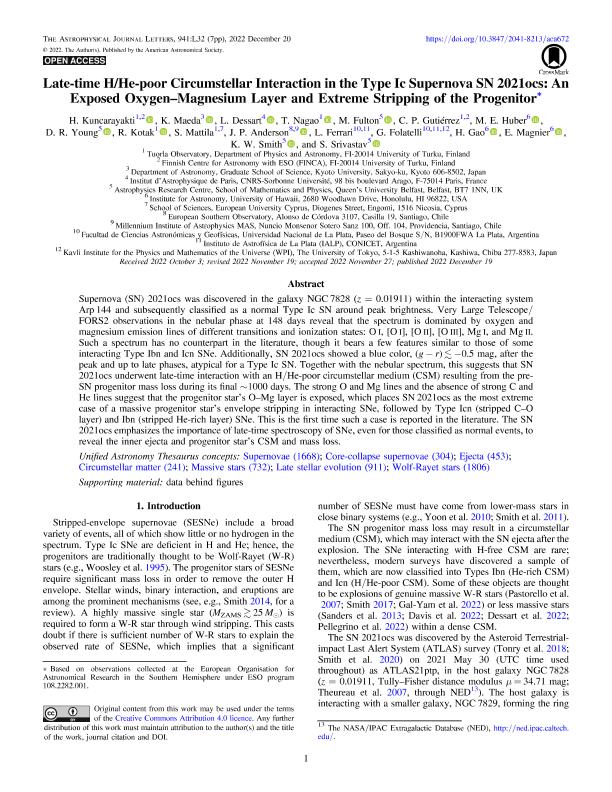Mostrar el registro sencillo del ítem
dc.contributor.author
Kuncarayakti, H.
dc.contributor.author
Maeda, K.
dc.contributor.author
Dessart, L.
dc.contributor.author
Nagao, T.
dc.contributor.author
Fulton, M.
dc.contributor.author
Gutiérrez, C. P.
dc.contributor.author
Huber, M. E.
dc.contributor.author
Young, D. R.
dc.contributor.author
Kotak, R.
dc.contributor.author
Mattila, S.
dc.contributor.author
Anderson, J. P.
dc.contributor.author
Ferrari, Lucía

dc.contributor.author
Folatelli, Gaston

dc.contributor.author
Gao, H.
dc.contributor.author
Magnier, E.
dc.contributor.author
Smith, K. W.
dc.contributor.author
Srivastav, S.
dc.date.available
2023-09-11T13:58:39Z
dc.date.issued
2022-12
dc.identifier.citation
Kuncarayakti, H.; Maeda, K.; Dessart, L.; Nagao, T.; Fulton, M.; et al.; Late-time H/He-poor Circumstellar Interaction in the Type Ic Supernova SN 2021ocs: An Exposed Oxygen-Magnesium Layer and Extreme Stripping of the Progenitor; American Astronomical Society; Astrophysical Journal Letters; 941; 2; 12-2022; 1-7
dc.identifier.issn
2041-8205
dc.identifier.uri
http://hdl.handle.net/11336/211096
dc.description.abstract
Supernova (SN) 2021ocs was discovered in the galaxy NGC 7828 (z = 0.01911) within the interacting system Arp 144 and subsequently classified as a normal Type Ic SN around peak brightness. Very Large Telescope/FORS2 observations in the nebular phase at 148 days reveal that the spectrum is dominated by oxygen and magnesium emission lines of different transitions and ionization states: O i, [O i], [O ii], [O iii], Mg i, and Mg ii. Such a spectrum has no counterpart in the literature, though it bears a few features similar to those of some interacting Type Ibn and Icn SNe. Additionally, SN 2021ocs showed a blue color, (g − r) ≲ −0.5 mag, after the peak and up to late phases, atypical for a Type Ic SN. Together with the nebular spectrum, this suggests that SN 2021ocs underwent late-time interaction with an H/He-poor circumstellar medium (CSM) resulting from the pre-SN progenitor mass loss during its final ∼1000 days. The strong O and Mg lines and the absence of strong C and He lines suggest that the progenitor star’s O-Mg layer is exposed, which places SN 2021ocs as the most extreme case of a massive progenitor star’s envelope stripping in interacting SNe, followed by Type Icn (stripped C-O layer) and Ibn (stripped He-rich layer) SNe. This is the first time such a case is reported in the literature. The SN 2021ocs emphasizes the importance of late-time spectroscopy of SNe, even for those classified as normal events, to reveal the inner ejecta and progenitor star’s CSM and mass loss.
dc.format
application/pdf
dc.language.iso
eng
dc.publisher
American Astronomical Society
dc.rights
info:eu-repo/semantics/openAccess
dc.rights.uri
https://creativecommons.org/licenses/by/2.5/ar/
dc.subject
Supernovae
dc.subject
Circumstellar matter
dc.subject
Massive stars
dc.subject.classification
Astronomía

dc.subject.classification
Ciencias Físicas

dc.subject.classification
CIENCIAS NATURALES Y EXACTAS

dc.title
Late-time H/He-poor Circumstellar Interaction in the Type Ic Supernova SN 2021ocs: An Exposed Oxygen-Magnesium Layer and Extreme Stripping of the Progenitor
dc.type
info:eu-repo/semantics/article
dc.type
info:ar-repo/semantics/artículo
dc.type
info:eu-repo/semantics/publishedVersion
dc.date.updated
2023-09-05T18:04:09Z
dc.identifier.eissn
2041-8213
dc.journal.volume
941
dc.journal.number
2
dc.journal.pagination
1-7
dc.journal.pais
Estados Unidos

dc.description.fil
Fil: Kuncarayakti, H.. Turun Yliopisto; Finlandia. Tuorlan Observatorio; Finlandia
dc.description.fil
Fil: Maeda, K.. Graduate School Of Science; Japón
dc.description.fil
Fil: Dessart, L.. Institut Dastrophysique de Paris; Francia
dc.description.fil
Fil: Nagao, T.. Tuorlan Observatorio; Finlandia
dc.description.fil
Fil: Fulton, M.. The Queens University of Belfast; Irlanda
dc.description.fil
Fil: Gutiérrez, C. P.. Turun Yliopisto; Finlandia. Tuorlan Observatorio; Finlandia
dc.description.fil
Fil: Huber, M. E.. University Hawaii Institute For Astronomy; Estados Unidos
dc.description.fil
Fil: Young, D. R.. The Queens University of Belfast; Irlanda
dc.description.fil
Fil: Kotak, R.. Tuorlan Observatorio; Finlandia
dc.description.fil
Fil: Mattila, S.. European University Cyprus; Chipre. Tuorlan Observatorio; Finlandia
dc.description.fil
Fil: Anderson, J. P.. European Southern Observatory Santiago; Chile. Instituto Milenio de Astrofísica; Chile
dc.description.fil
Fil: Ferrari, Lucía. Consejo Nacional de Investigaciones Científicas y Técnicas. Centro Científico Tecnológico Conicet - La Plata. Instituto de Astrofísica La Plata. Universidad Nacional de La Plata. Facultad de Ciencias Astronómicas y Geofísicas. Instituto de Astrofísica La Plata; Argentina
dc.description.fil
Fil: Folatelli, Gaston. Consejo Nacional de Investigaciones Científicas y Técnicas. Centro Científico Tecnológico Conicet - La Plata. Instituto de Astrofísica La Plata. Universidad Nacional de La Plata. Facultad de Ciencias Astronómicas y Geofísicas. Instituto de Astrofísica La Plata; Argentina
dc.description.fil
Fil: Gao, H.. University Hawaii Institute For Astronomy; Estados Unidos
dc.description.fil
Fil: Magnier, E.. University Hawaii Institute For Astronomy; Estados Unidos
dc.description.fil
Fil: Smith, K. W.. The Queens University of Belfast; Irlanda
dc.description.fil
Fil: Srivastav, S.. The Queens University of Belfast; Irlanda
dc.journal.title
Astrophysical Journal Letters
dc.relation.alternativeid
info:eu-repo/semantics/altIdentifier/doi/http://dx.doi.org/10.3847/2041-8213/aca672
dc.relation.alternativeid
info:eu-repo/semantics/altIdentifier/url/https://iopscience.iop.org/article/10.3847/2041-8213/aca672
Archivos asociados
